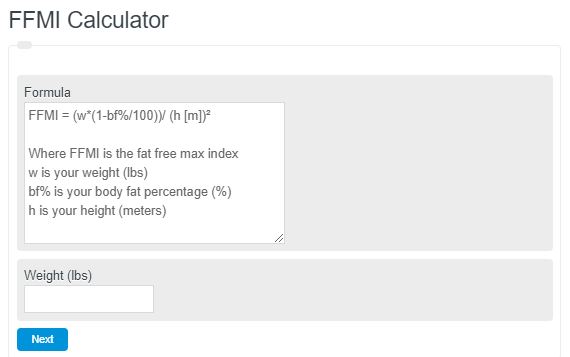Enter your height, weight, and body fat percentage into the calculator below to determine your fat-free mass index, known as FFMI. FFMI is a measure of muscle mass in relation to your height and weight. Compare your results with the table below.
FFMI Formula
The following formula is used by this calculator to determine your FFMI:
FFMI = (w*(1-bf%/100))/ (h [m])²
- Where FFMI is the fat-free max index
- w is your weight (lbs)
- bf% is your body fat percentage (%)
- h is your height (meters)
FFMI Definition
FFMI stands for Fat-Free Mass Index. It is a measure of the amount of muscle mass an individual has relative to their height. FFMI is important because it helps assess an individual’s muscle development and overall body composition, which can be useful in various contexts such as sports performance, nutrition planning, and monitoring changes in muscle mass over time.
What does my FFMI mean?
The higher your FFMI the more muscle mass you have compared to your body area. Anything above 58 is unlikely to occur naturally in humans. Therefore, people with an FFMI greater than 58 likely used steroids.
FFMI depends on height, weight, and body fat percentage. As a result, the only way to change your FFMI is to either lose body fat% or gain muscle. In reality, gaining muscle will lower your body fat percentage, so it’s a direct correlation.
What is a healthy FFMI?
There is no set value for a healthy FFMI, but in general body fat percentages between 10-205 are considered healthy.
Frequently Asked Questions (FAQ)
How can I calculate my body fat percentage for the FFMI formula?
You can calculate your body fat percentage using various methods, such as bioelectrical impedance analysis (BIA) devices, skinfold measurements with calipers, or more precise methods like DEXA scans. Online calculators are also available if you have measurements like your waist, neck, and hip circumference.
Is FFMI a better indicator of fitness than BMI?
FFMI is often considered a more accurate measure of fitness for individuals who are very muscular, as it takes into account muscle mass rather than just height and weight like BMI (Body Mass Index). While BMI can categorize very muscular individuals as overweight or obese, FFMI provides a clearer picture of body composition.
How can I improve my FFMI?
Improving your FFMI involves increasing muscle mass and/or decreasing body fat. This can be achieved through resistance training to build muscle and a balanced diet to either gain lean mass or lose fat. Consistency and a well-planned fitness routine are key.
Are there any risks associated with a high FFMI?
An FFMI significantly above natural limits (e.g., > 25 for men and > 21 for women) might indicate steroid use, which comes with health risks. Naturally, a high FFMI achieved through proper nutrition and training is generally positive, reflecting good muscle development and fitness levels. However, obsessing over numbers can sometimes lead to unhealthy behaviors, so it’s important to focus on overall health and well-being.
